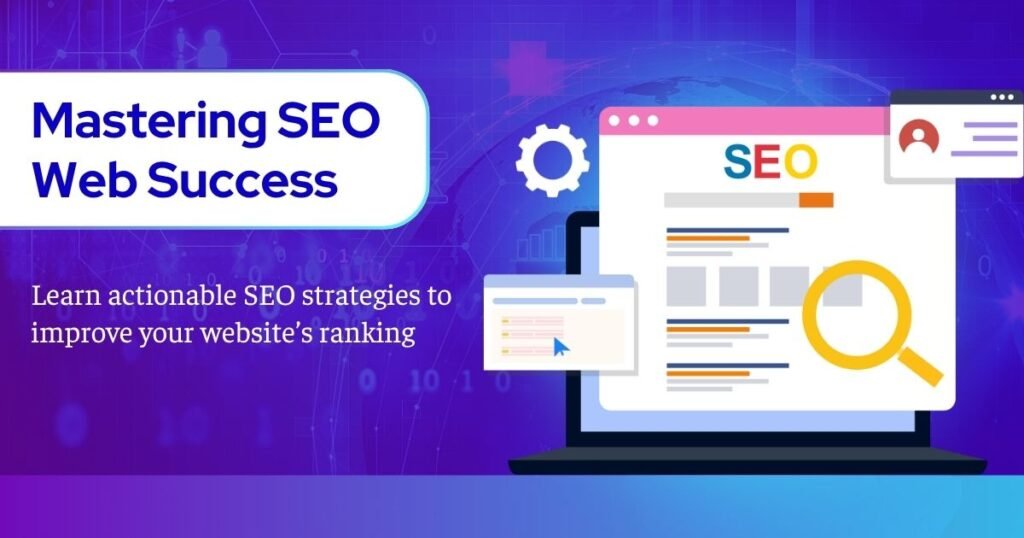Mastering SEO for Web Success

Search engine optimization is the rudder of a website’s success. Businesses, bloggers, and content creators also rely on SEO to ensure that their sites rank high in a given search engine like Google. But how do you learn to have an effective SEO strategy amid such stiff competition?
Here are fundamental principles of SEO for your website and if you are just beginning in this field or looking to improve yourself, this guide will give some very practical tips that should take you the distance.
Why SEO Matters for Your Website
Imagine investing time and resources into creating a stunning website, only for it to be hidden on the tenth page of Google. SEO ensures your site is visible, attracting organic traffic and turning visitors into customers.
Here’s why it’s crucial:
- Increase visibility: Proper SEO techniques ensure your website appears at the top of search engine results pages (SERPs), improving your site’s exposure.
- Drive organic traffic: Unlike paid advertising, SEO helps generate traffic naturally, saving money in the long run.
- Enhance trust and credibility: Users trust search engines. Ranking high signals that your site is a reliable source of information.
- Improve user experience: Good SEO practices often go hand-in-hand with creating user-friendly websites.
Understanding its significance is just the beginning. Now, let’s break down the core steps to optimize your website for SEO success.
Mastering On-Page SEO
On-page SEO focuses on optimizing elements directly on your website. From content to technical details, these are the areas you must prioritize:
Choosing the Right Keywords
Keywords are the foundation of SEO. They help search engines understand what your content is about.
- Research keywords effectively: Use tools like Google Keyword Planner, SEMrush, or Ahrefs to find high-volume, low-competition keywords relevant to your niche.
- Focus on intent: Distinguish between informational (“how to bake a cake”), navigational (“best cake recipe sites”), and transactional (“buy baking supplies online”) keywords. Use them appropriately in your content.
- Ensure strategic placement: Place keywords naturally in titles, subheadings, URLs, and the first 100 words of your text.
Pro Tip:
Long-tail keywords (phrases with 3+ words) have lower competition and are highly targeted, improving your chances of ranking.
Crafting High-Quality Content
Google prioritizes valuable, relevant, and unique content. Here’s how to ensure your content stands out:
- Provide solutions to user queries.
- Use structured headers (H1, H2, H3) for better readability and SEO optimization.
- Write engaging meta titles and descriptions that integrate keywords while enticing readers.
- Update content regularly to maintain relevance.
Optimizing Title Tags and Meta Descriptions
Your title tag is often the first thing users see in search results.
- Keep titles under 60 characters and meta descriptions around 155 characters.
- Integrate primary keywords to help search engines and readers identify the content’s relevance.
- Create compelling headlines. A strong headline can make or break a reader’s decision to click.
Image Optimization
Images improve user engagement, but they also need optimization to support SEO goals:
- Use descriptive file names (e.g., “seo-guide.jpg” instead of “IMG1234.jpg”).
- Add alt text with keywords to help visually impaired users and improve image search rankings.
- Compress images to reduce file size and improve loading speed.
Behind the Scenes with Technical SEO
Technical SEO ensures your website is easy to crawl and index. Here’s what you need to know:
Improve Site Speed
Users and search engines prioritize fast-loading websites. Slow speeds lead to higher bounce rates. Use tools like Google PageSpeed Insights to identify speed issues.
Steps to improve speed include:
- Compress images and media files.
- Enable browser caching.
- Optimize your code by reducing unnecessary CSS and JavaScript.
Adopt Mobile-First Design
Google predominantly uses the mobile version of websites for indexing and ranking. Make sure your site:
- Is mobile-responsive.
- Offers easy navigation on smaller screens.
- Loads quickly on mobile devices.
Set Up an SSL Certificate
Security is non-negotiable for modern websites. Switching to HTTPS with an SSL certificate signals to users (and search engines) that your site is trustworthy.
Use Schema Markup
Schema markup makes it easier for search engines to identify key data on your site, such as reviews, pricing, and FAQs. Rich snippets stand out in search results, increasing click-through rates (CTR).
The Value of Off-Page SEO
Off-page SEO involves activities that occur outside your website but impact your search engine rankings. Here’s how to do it right:
Build Quality Backlinks
Backlinks (links from other sites to yours) act as “votes of confidence.”
- Focus on quality over quantity. Links from authoritative, relevant sites carry more weight than spammy directories.
- Guest post on credible blogs in your niche.
- Use broken link-building tactics by identifying broken links on websites and suggesting your own relevant content as a replacement.
Leverage Social Media
While social media does not directly impact SEO rankings, it drives traffic and fosters engagement, helping your site gain visibility.
- Share blog posts and other website content on platforms like LinkedIn, Twitter, and Instagram.
- Interact with your audience to encourage shares and clicks.
Measure Your SEO Performance
SEO success requires continuous monitoring. These are the tools you can use to measure performance:
- Google Analytics tracks your site’s traffic, user behavior, and keyword performance.
- Google Search Console provides insights into your search visibility, backlink profile, and technical errors.
- SEMrush or Ahrefs evaluates how your SEO strategies compare against competitors.
Key metrics to monitor:
- Organic traffic and bounce rate
- Keyword rankings
- Domain authority (DA) and page authority (PA)
Achieve Long-Term SEO Success
SEO isn’t a one-time job. It is an ongoing process. By implementing strategies described above, your site can become optimized for higher ranking, attract organic traffic, and provide users with an exceptional experience.
We are now in the latter half of 202,0 and the SEO landscape is changing. If you’re struggling for ideas, take a look back through your journal and see what’s been on your mind recently. Once you’ve gathered some clues, turn to treat them as potential keywords in future research or content marketing projects!








